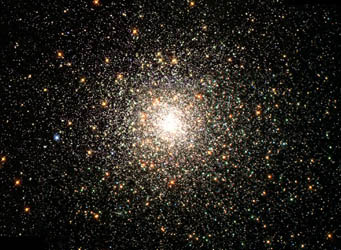Any parent of teenagers will tell you that it's often a challenge to keep enough food in the house. It's amazing how often — and how much — they can eat.
The same could be said for the appetite of our home galaxy.
Today the Milky Way and the Andromeda Galaxy (M31) are the massive "anchors" in the Local Group of galaxies, about 30 denizens in all. Most of these are dwarf galaxies, diminutive systems such as the Magellanic Clouds with several billion stars (compared to our galaxy's 200 to 400 billion). But in the past there must have been far more dwarfs, and astronomers have assumed for some time that the Milky Way was a ravenous teenager, having devoured many if not most of the dwarfs in its immediate vicinity.
Like crime-scene investigators, observers have been looking for evidence of the Milky's Way's fits of cannibalism in the halo of matter that surrounds its main spiral; that's where the stars, gas, dark matter, and globular clusters from the consumed victims end up. Two recent publications demonstrate that cosmic detectives have chased down some promising leads.

Located about 28,000 light-years away in Scorpius, Messier 80 (NGC 6093) is a stunning example of the more than 150 globular star clusters known to encircle the Milky Way. Its hundreds of thousands of stars are held together by their mutual gravitational attraction. Click here for a larger version.
Hubble Heritage Team (AURA / STSc / NASA)
First comes word, from Duncan Forbes and Terry Bridges of Australia's Swinburne University, that up to one quarter of the Milky Way's globular clusters formed elsewhere and migrated into its halo. The observers used the Hubble Space Telescope to assess the age and composition of dozens of globulars lying within about 65,000 light-years of our galaxy's center, then pooled their data with other observations.
The upshot, described in a paper submitted to Monthly Notices of the Royal Astronomical Society, is that roughly 25% of the Milky Way's globulars came from 6 to 8 dwarf galaxies accreted by the Milky Way over time. As Forbes notes in a Society press release, "Our work shows that there are more of these accreted dwarf galaxies in our Milky Way than was thought."
More evidence of the Milky Way's unsated appetite comes from Anna Frebel (Center for Astrophysics), Evan Kirby (Caltech), and Joshua Simon (Carnegie Observatories). In the March 4th issue of Nature, they make the case that a star in the Sculptor dwarf galaxy is chemically similar to the Milky Way's oldest stars and thus might be among the earliest stars to form after the Big Bang.
Frebel's team identified an 18th-magnitude star in the Sculptor that contains almost no "metal" — a term astrophysicists apply to any elements other than hydrogen or helium. In fact, this star has only 1/6000 the heavy-element content of the Sun.
Here's why that matters: Stars cook up heavy elements through fusion and supernovas, and every subsequent generation of stars incorporates the elemental ashes left by its predecessors. If a star lacks these "metals," it must have formed too long ago to have swept up the recycled carbon, iron, and other elements found in younger stars.
By this measure, lots of stars in the Milky Way are quite old — but such ancient suns had never been found in the feedstock of dwarfs that surround it. "If dwarf galaxies were the original components of the Milky Way," explains Simon in a press release, "then it's hard to understand why they wouldn't have similar stars." Now that one's been found, he adds, the idea that the Milky Way's halo represents the corpses of many dwarf galaxies "does indeed appear to be correct."
 3
3
Comments
andre
March 12, 2010 at 4:27 pm
In globular Clusters some times blue stars are found. It is impossible with an very old star, unless it result from collision os two small stars from recent time to merge to a large and blue one.
Similar, with two or more red dwarfs, with a expected hundred billion years old lifetime, with little metal formed nowadays, such a collision will result in a larger one, perhaps like our sun, with little metal, like a baby sun like star.
You must be logged in to post a comment.
Rod
March 18, 2010 at 6:47 pm
This report suggests that at least 25% of the Milky Way GCs have H-R diagram dating problems where a mixed bag of ages show up from the computer simulations thus the need to reconcile the data. H-R diagrams have age problems as well as calculations using the s-process or r-process to measure stellar ages in the Milky Way.
You must be logged in to post a comment.
Rod
March 18, 2010 at 6:47 pm
This report suggests that at least 25% of the Milky Way GCs have H-R diagram dating problems where a mixed bag of ages show up from the computer simulations thus the need to reconcile the data. H-R diagrams have age problems as well as calculations using the s-process or r-process to measure stellar ages in the Milky Way.
You must be logged in to post a comment.
You must be logged in to post a comment.